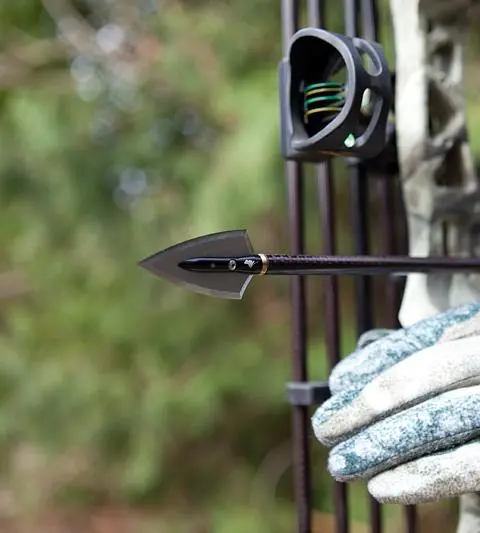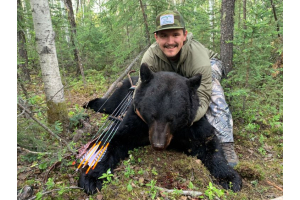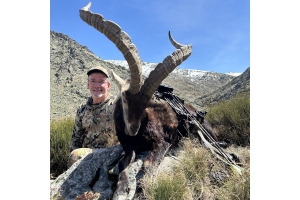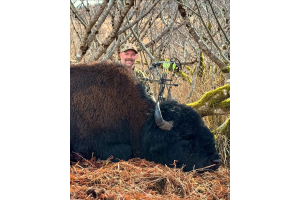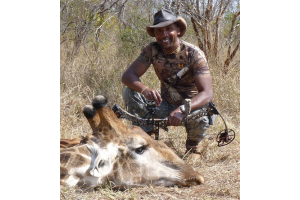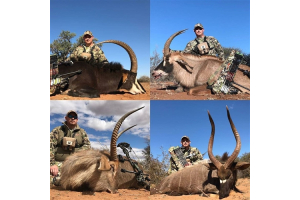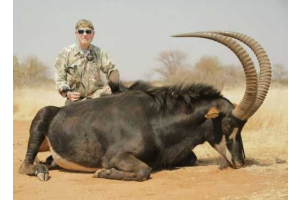Building the Ultimate Hunting Arrow by Dr. Ed Ashby

On any given shot, when a hunting arrow impacts real tissues several arrow design features come into play, all of which determine arrow penetration. What are these features; what part do they play in penetration; how important is each; and why?
First, let’s set aside “shot placement”. I’ve yet to meet an experienced bowhunter who claims he’s never hit an animal in “the wrong place”. This can result from a muffed shot; an animal jumping the string; deflection of the arrow by an unseen obstacle; or a myriad of other causes.
The lethality study data contains abundant instances of ideally placed shots failing to be lethal. These occur when a shortcoming in the “arrow system” prevents adequate penetration. They become more numerous as animal size or toughness increases, but occur with lighter built animals too; merely less frequently.
The foregoing is not to deride shot placement. In a hunting situation, both the target and the environment are dynamic. Because of its mutability, no bowhunter has absolute control over the shot. What one does have absolute control over is the arrow used. This article’s focus is arrow features which determine the penetration on “any given shot”, regardless of where the shot impacts the animal.
Let’s also set aside broadhead sharpness. This is a given. Only extremely sharp broadheads should be used to hunt big game. Sharpness is a factor in penetration, but broadhead keenness and the ability to retain sharpness, regardless of the tissues encountered, is a precondition for arrow lethality.
The bow is drawn; the arrow loosed. From this point forward, all that matters are the arrow’s characteristics and impact force.
The arrow system: all components.
The number one factor; the single most important arrow feature; is the structural integrity of the arrow system: broadhead; shaft; and all shaft components. To reliably achieve effective, predictable penetration resulting in a lethal hit, the broadhead and the shaft must remain undamaged; regardless of tissues encountered or the angle of impact with those tissues.
The broadhead is the single most important piece of bowhunting equipment one carries afield. It is the item that should be selected first; then the hunting arrow developed around the chosen broadhead. A broadhead that becomes damaged, even slightly, reduces penetration severely.
The “ideal broadhead” has several characteristics.
(1) reasonable metal thickness
(2) quality steel
(3) neither bends nor breaks on bone impact
(4) Rockwell hardness from 49 to 55
(5) tends to break before taking a bend
(6) long and narrow shape (high mechanical advantage)
(7) long ferrule taper, fading smoothly into the blade
(8) no abrupt junctures anywhere
(9) straight taper cutting edges. These criteria reflect the broadhead’s integrity, its capacity to take and maintain a sharp edge, and its ability to maximize the use of the arrow's impact force.
Though it is the broadhead that must ultimately perform, the shaft must remain undamaged to enable broadhead performance. The most common shaft failure is immediately behind the broadhead taper. It is at this critical junction that aluminum inserts and/or adaptors commonly give way. The farther the impact angle deviates from perpendicular the more frequent this failure becomes. Such a failure effectively destroys the arrow’s penetration potential.
With synthetic shafts, using steel broadhead adaptors with aluminum inserts increases strength at this weak point. Additional strengthening is achievable by using brass or steel inserts. Longer inserts, extending farther into the shaft, provide even more strength.
It is also at this junction that wood shafting is most frequently damaged on impact. Certain woods; either as primary shafting or as a footing; provide excellent integrity, increasing the penetration potential. Among these are: Forgewood; hickory; laminated birch; and several exotic hardwoods, such as ipe and purple heart.
Arrow Flight. Hand-in-hand with arrow integrity is the quality of arrow flight. Perfect flight capitalizes on all other penetration features of the arrow. It comes second only because, even with perfect flight, an arrow damaged at impact, or during penetration, loses almost all penetration potential, and all control of the arrow's path through the tissues.
Poor flight places additional stress on arrow components at impact, and during penetration. On broadside shots, it causes resistance to be oblique to the arrow’s direction of tack, rather than perpendicular. It also increases “shaft flexion” secondary to impact. The resultant oscillation, or ‘noodling’, causes vacillation of the arrow’s force vector during penetration, increasing shaft drag.
Decreased penetration secondary to shaft flex is commonly observed. Less than perfect flight at extremely close ranges; resulting from arrow paradox; causes a conspicuous penetration decrease; compared to a slightly longer range shot.
Those who commonly make multiple-shafted arrows for use on very large game know how difficult achieving perfect arrow flight can be. They also know just how critical perfect arrow flight is to arrow penetration … regardless of impact force.
Once a structurally sound, perfectly flying arrow impacts tissues other design features come into play. It is difficult to “rank” the importance of these features, but study results suggest the following order.
Shaft diameter to ferrule diameter ratio. This relationship is clearly defined in testing. A shaft diameter greater than that of the broadhead’s ferrule averages a 30 percent loss in penetration through fresh, real animal tissues; compared to a shaft diameter equaling the broadhead’s ferrule. A shaft diameter less than that of the ferrule results in a 10 percent average penetration increase. This design feature can change outcome penetration by 40 percent.
The 30 percent penetration loss resulting from the use of a shaft diameter larger than the broadhead’s ferrule demonstrates the influence of shaft drag on penetration. Reducing resistance is a “free gift”; providing penetration gains equaling very large increases in impact force.

A favorable shaft to ferrule diameter ratio (Right) averages 40 percent more tissue penetration than when the ratio is unfavorable (Left).
Arrow mass. Placement of arrow mass this high on the list of important penetration features results not only from the increased momentum high mass arrows mass derive, and maintain downrange, from a given bow, but because of the “heavy bone threshold”. There is a persistent, repeatable threshold value of arrow mass at which the frequency of heavy bone penetration suddenly, and dramatically, increases. It lies somewhere very near 650 grains.
The heavy bone threshold is more dependent on arrow mass than impact force. A substantial increase in impact force is required to achieve the same frequency of heavy bone penetration with arrow mass below this threshold. At threshold mass, a wide range of impact forces give equal frequency of heavy bone penetration. Overall penetration, after breaching heavy bone, is more closely related to arrow impact momentum.
It is theorized that the heavy bone threshold represents a “time of impulse” of arrow force of sufficient duration to exceed the flexional limit of most heavy bone; a point at which whatever force the arrow does carry is applied to the bone for a long enough period of time to surpass the bone’s limit of elasticity. A detailed discussion of the “heavy bone threshold” can be found in 2005 Arrow Lethality Study Update, Part 6.
Weight forward of center (FOC). Carbon shaft testing indicates that extreme FOC has a major influence on penetration. This is qualified as “carbon shafting” because I have been unable to get a perfect flight with extreme FOC arrows having any other shaft material. Substantial penetration gain occurs with arrows having a FOC greater than 18 percent.
Using arrows identical in all aspects except FOC; extreme FOC arrows show a penetration increase of 20 percent for arrows of 800 grains and upwards of 50 percent for arrows of 650 grains. This does not imply that arrows of 650 grains mass show greater penetration than those of 800 grains. Higher mass arrows of ‘normal’ FOC show greater penetration than those of lesser mass; ergo, though the measured gain may be equal, the percentage gain is less.
Testing of extreme FOC arrows is in the early stages, but the magnitude and consistency of initial results leave no doubt they offer a significant penetration increase. Further testing may warrant the placement of this factor higher on the list.
What is the theory behind extreme FOC penetration increase? Low shaft mass behind the arrow’s center of gravity results in less shaft flex on impact, and during penetration. As with perfect flight, reducing shaft oscillation reduces shaft drag, retaining more arrow force for penetration.
Having extreme FOC means the arrow’s front pulls the rear portion through the tissues. A more rearward center of mass pushes the arrow’s front portion through the tissues, instigating shaft flexion. To understand the effect, place a string on a table. Place your finger on one end of the string and pull the string along. There is little flexion of the trailing string. Now try to push the string from the rear! The effect with an arrow shaft is the same. The only difference is the degree of ‘noodling’ each exhibit.
A detailed discussion of FOC and tissue penetration, along with definitions for “normal, high, and extreme FOC” and the applicable formula for calculating FOC, can be found in 2005 Arrow Lethality Study Update, Part 2.
The broadhead’s edge bevel. Testing, using arrows identical in all aspects except the broadhead’s edge bevel, indicates single bevel edges offer an advantage when a bone is encountered. Depending on broadhead profile and mechanical advantage, single-bevel broadheads show a penetration gain varying from 30 to almost 60 percent. When no bone is encountered, single-bevel penetration gain is of less significance.
A single bevel broadhead causes arrow rotation during penetration. The direction of rotation must be the same as that caused by the fletching. Failure to do so results in a penetration loss. On bone impact shots, the penetration loss when rotation does not match ranges from 40 to 70 percent (again, depending on broadhead profile and mechanical advantage).
Increased bone penetration of single-bevel broadheads occurs because of their tendency to split bone apart rather than force a path through. Bone splits are the norm, rather than the exception, with single-bevel broadheads. The frequency and magnitude of “single bevel induced” bone splits are greater in the ribs, humerus, or femur than in the scapula, pelvis, sternum, or spine, but occur frequently with all.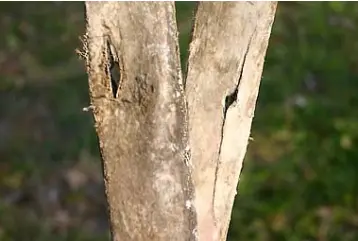 Typical single bevel bone split (R), and double bevel hole (L). Five-inch split in heavy rib bone of an Asian Buffalo is from single bevel Grizzly Extreme, 11/16” wide.
Typical single bevel bone split (R), and double bevel hole (L). Five-inch split in heavy rib bone of an Asian Buffalo is from single bevel Grizzly Extreme, 11/16” wide.
Shaft Profile. With normal to high FOC arrows, and possibly extreme FOC arrows too, shaft profile affects penetration. In fresh tissues, tapered shafts out-penetrate parallel and barrel-tapered shafts of the same mass, force, material, and shaft finish, by 8 to 15 percent. Whether this penetration gain is an effect of the slight FOC increase or other factors, is unclear. With like materials, tapered shafts have a higher FOC. The taper may act as a reverse inclined plane, constantly lowering the rate of increase in shaft drag the deeper it penetrates. The progressively increasing cavity created between the shaft and tissues may facilitate the flow of shaft-lubricating blood, reducing friction.
Shaft finish. ‘Slicker’ shaft finishes reduce friction between the shaft and tissues, retaining more force for penetration. Some finishes become ‘slicker’ than others in the presence of blood. The lubricating effect further reduces tissue resistance.
Broadhead finish. Teflon-coated broadheads show a penetration gain in soft and extremely fibrous tissues. It makes little difference in bone penetration. The retained arrow force may, however, be of significance on shots penetrating fibrous tissues, or substantial amounts of soft tissue, prior to encountering bone. Its use offers potential benefits, and no disadvantages.
Impact Force. Last on the list is arrow impact force; the total momentum at impact. Fresh tissue test; conducted immediately after expiration, before tissue changes become an influencing factor; shows no correlation of impact kinetic energy as a predictor of penetration. Impact momentum shows a positive correlation. A detailed discussion of the physics of arrow penetration can be found in Momentum, Kinetic Energy, and Arrow Penetration (And What They Mean for the Bowhunter)2; with additional information in 2005 Arrow Lethality Study Update, Part 51
The placement of impact force last is appropriate for a number of reasons. Arrow force is easily squandered by the use of arrows lacking the aforementioned qualities. A perfectly modeled, perfect flying arrow, maximizing the penetration potential of whatever force it carries, will out-penetrate a poorly constructed and/or poorly flying arrow of vastly greater impact force. This does not mean that bow efficiency is of no consequence. It simply means maximizing arrow force becomes a significant factor only when the arrow functions without fail.
Into working parameters, one must also incorporate all “what if” situations. To reach vital areas on less than perfect shots greater penetration potential is often required to overcome heavier resistance force.
The most potent bowhunting setup generates a low level of impact force, relative to other hunting weapons. A hand-thrown spear, of mass, typically used by many primitive tribes, generates up to ten times the impact momentum of a high-performance bowhunting rig. With little force available, the hunting arrow must maximize penetration potential by: (1) minimizing the resistance encountered and, (2) maximizing the “work” (as applied in physics) the arrow can do with the force available.
Based on testing to date, the forgoing is the order in which I rate hunting arrow design features’ influence on penetration, but one should not think of it as a “ranking of importance”. Take *6a look at your hand. Which digits are most important for it to accomplish its many tasks?
Certainly, the thumb is number one. The use of an opposable thumb allows one to grip securely and perform delicate tasks; but which digit is next most important? Most rate the index finger next, for its ability to work with the opposable thumb in tasks requiring dexterity and precise manipulation. Few would willingly give up any of their hand’s digits. Giving up
any significantly diminishes versatility and the ability to efficiently perform tasks.
Hunting arrow components are the same. System integrity is as crucial to hunting arrow performance as the thumb is to the human hand. If removed, the arrow’s main function is effectively negated. Flawless arrow flight is analogous to the index finger; vital to getting efficient and versatile performance from a structurally dependable arrow. The other factors enhance the hunting arrow’s ability to perform under a variety of circumstances; delivering a quick, humane killing shot under as many hunting situations as possible.


